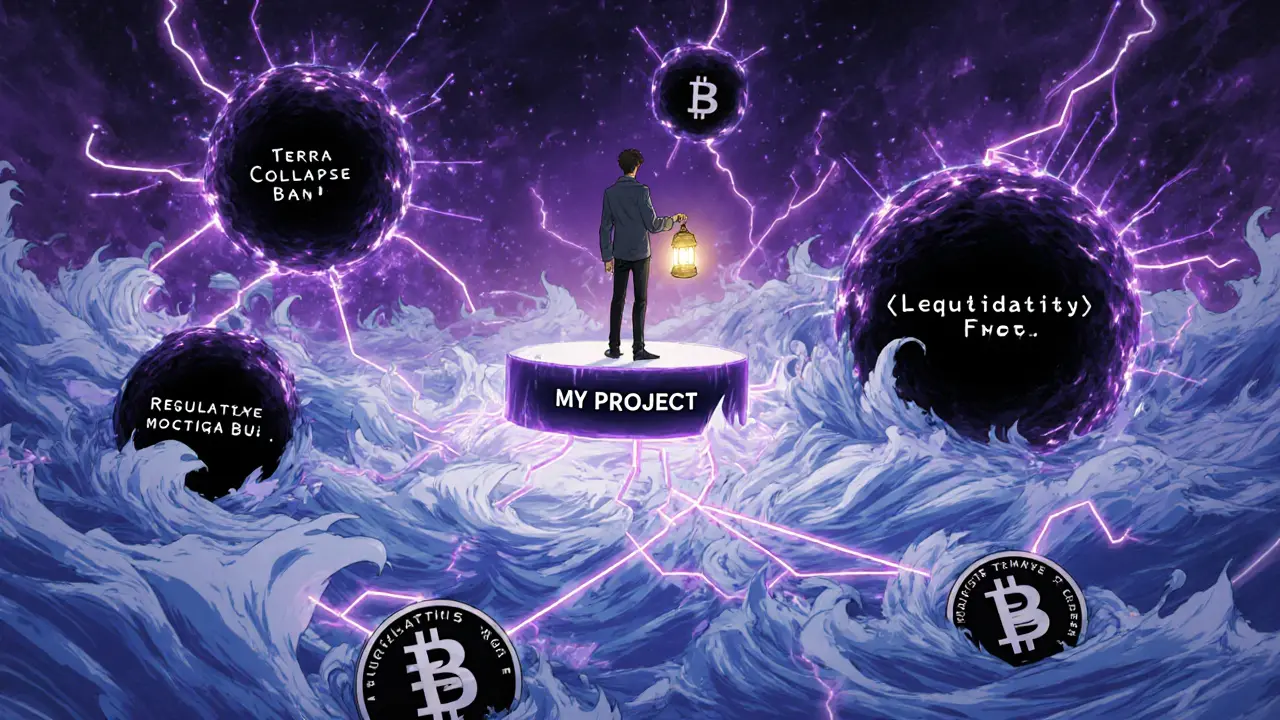Risk Score Calculator
Assess Your Project Risk
Use the systematic risk framework from the article. Score each risk by impact (1-5) and likelihood (1-5).
Risk Matrix Guide
| Likelihood | 1 | 2 | 3 | 4 | 5 |
|---|---|---|---|---|---|
| 5 | High | High | High | High | High |
| 4 | High | Medium | Medium | Medium | High |
| 3 | Medium | Medium | Medium | Medium | High |
| 2 | Medium | Medium | Medium | Medium | Low |
| 1 | Low | Low | Low | Low | Low |
Risk Assessment Results
When you invest in blockchain or run a decentralized project, you’re not just betting on technology-you’re betting on a system that can collapse from a single ripple across the market. A hack on one exchange? A regulatory crackdown in one country? A sudden drop in liquidity? These aren’t isolated incidents. They’re systematic risks-threats that hit entire markets, not just single projects. Most crypto traders and founders still treat risk like a checklist: ‘We’ve got two-factor auth, we’ve audited the smart contract, we’re good.’ But that’s not enough. If you’re not managing risk systematically, you’re flying blind in a storm.
What Is Systematic Risk in Blockchain?
Systematic risk in blockchain isn’t about a smart contract bug or a rug pull. It’s about the forces that shake the whole ecosystem: regulatory shifts, macroeconomic crashes, exchange failures, or even a major blockchain network going offline. Think 2022-when TerraUSD collapsed, it didn’t just kill one token. It triggered a domino effect: lenders froze withdrawals, DeFi protocols lost billions, and Bitcoin dropped 40% in days. No amount of diversification within crypto could have saved you. That’s systematic risk: unavoidable, interconnected, and systemic.
Unlike idiosyncratic risk (which affects one project), systematic risk affects every player. You can’t hedge it by holding more coins. You can’t avoid it by switching chains. The only way to respond is with a structured, ongoing approach-not a one-time audit or a panic sell-off.
Why Traditional Risk Management Fails in Crypto
Most crypto teams still use old-school risk methods: ‘We’ll list our token on three exchanges,’ ‘We’ll hire a security firm,’ ‘We’ll do quarterly reviews.’ These are reactive, siloed, and often too late. A smart contract audit might catch a coding flaw, but it won’t predict a global Fed rate hike that causes retail investors to dump everything. A KYC process won’t stop a government from banning staking. A Discord mod can’t stop a coordinated short attack.
Traditional risk management treats each threat like a separate fire. Systematic risk management sees the whole building on fire-and builds firebreaks before the flames spread. In crypto, where markets move 24/7 and news travels in seconds, waiting for a crisis to strike is a death sentence.
The Five Pillars of a Systematic Risk Management Approach
Here’s what a real systematic risk management framework looks like in blockchain:
- Continuous Risk Identification - Don’t just list risks once. Set up automated alerts for on-chain anomalies, regulatory announcements, exchange downtime, and social sentiment spikes. Tools like Nansen or Chainalysis can flag unusual wallet behavior or large sell-offs before they hit the news.
- Impact and Likelihood Scoring - Use a simple 5x5 risk matrix. For each threat, score its potential impact (1-5) and likelihood (1-5). A 5/5 risk? That’s your priority. Example: ‘Regulatory ban on staking in the EU’ - high impact, medium likelihood. That’s worth a contingency plan.
- Scenario Planning and Wargaming - Run simulations. What if Coinbase goes down for 72 hours? What if Ethereum gas spikes to $500? What if a major miner pool colludes to censor transactions? Map out how your project would respond. Test your team’s reaction time. Document decisions in advance.
- Centralized Risk Register - Use a GRC platform like LogicGate, Drata, or even a shared Notion doc with version control. Every risk gets a title, owner, status, mitigation plan, and review date. No more spreadsheets buried in someone’s Dropbox.
- Feedback Loops and Post-Mortems - After every major event-successful or disastrous-hold a 30-minute review. What worked? What didn’t? What did you miss? Turn each event into a learning step. This turns risk management from a chore into a competitive advantage.

Technology That Makes Systematic Risk Management Possible
You can’t manage systematic risk manually. You need tools that work at blockchain speed.
- On-chain monitoring tools - Etherscan, Arkham, or Dune Analytics let you track wallet movements, token flows, and liquidity changes in real time. A sudden 20% drop in LP tokens? That’s a red flag.
- Automated alert systems - Set up Slack or Discord bots that ping your team when a key address moves over $10M, or when a regulatory keyword appears in a news feed.
- Decentralized insurance protocols - Platforms like Nexus Mutual or Cover Protocol let you buy coverage against smart contract exploits or oracle failures. It’s not a cure, but it’s a financial safety net.
- AI-driven sentiment analysis - Tools like LunarCrush or TheTie analyze Twitter, Reddit, and Telegram to detect panic or FOMO before it turns into a market crash.
These aren’t luxuries. They’re table stakes. If your team still relies on manual spreadsheets and gut feelings, you’re operating at a severe disadvantage.
Real-World Failure: What Happens Without Systematic Risk Management
Look at Celsius Network in 2022. They promised 15% APY on crypto deposits. They didn’t have a systematic risk plan. They didn’t monitor liquidity thresholds. They didn’t stress-test their model against a market crash. When Bitcoin fell and withdrawals spiked, they ran out of cash. No one saw it coming? That’s not luck-it’s negligence.
Compare that to Coinbase. They built a risk engine that monitors liquidity, counterparty exposure, and regulatory signals 24/7. When FTX collapsed, Coinbase didn’t panic. They had pre-approved liquidity buffers, clear communication plans, and automated withdrawal limits. They didn’t avoid risk-they managed it systematically.

How to Start Today (Even If You’re a Solo Founder)
You don’t need a $10M budget. You don’t need a team of 10. Here’s your 7-day action plan:
- Day 1 - List your top 5 worst-case scenarios. Be brutal. ‘We get hacked.’ ‘We get banned in the US.’ ‘Our main liquidity pool dries up.’
- Day 2 - Score each on impact (1-5) and likelihood (1-5). Highlight anything scoring 8+.
- Day 3 - For your top risk, write a one-page response plan. Who does what? What’s the trigger? What’s the backup?
- Day 4 - Set up one automated alert. Example: ‘Notify me if ETH price drops below $2,800.’ Use free tools like CoinGecko alerts or Telegram bots.
- Day 5 - Share your top risk and plan with one trusted person. Ask: ‘What did I miss?’
- Day 6 - Schedule a monthly 15-minute risk review. Put it in your calendar now.
- Day 7 - Bookmark one GRC tool (even the free tier). Start logging risks. Just one.
That’s it. You’ve started. You’re no longer guessing. You’re managing.
The Bigger Picture: Why This Matters Beyond Your Wallet
Systematic risk management isn’t just about survival. It’s about trust. Investors, partners, and users don’t care how fancy your whitepaper is. They care if you’ve thought through the worst. If you can show a clear, documented risk framework, you’re already ahead of 90% of crypto projects.
And as regulation tightens globally, projects that can prove they manage risk systematically will be the only ones allowed to operate. The ones that don’t? They’ll vanish in the next downturn.
Blockchain isn’t a wild west anymore. It’s a high-stakes financial system. And in financial systems, the winners aren’t the ones with the flashiest tech-they’re the ones who know how to survive when everything goes wrong.
Is systematic risk the same as market risk in crypto?
Yes, in practice, systematic risk in crypto is often called market risk. It refers to broad, economy-wide events that affect most or all assets-like interest rate changes, geopolitical tensions, or regulatory crackdowns. Unlike individual project risks (e.g., a smart contract bug), systematic risk can’t be eliminated by diversifying your portfolio. If Bitcoin, Ethereum, and Solana all crash together, you’re exposed.
Can I use traditional finance risk tools in blockchain?
Some tools work, but many don’t. Traditional VaR (Value at Risk) models assume normal market behavior-something crypto rarely follows. Monte Carlo simulations can help, but only if you feed them realistic crypto volatility data. Risk matrices and scenario planning work well. But don’t rely on bond market models for DeFi protocols. Crypto moves differently-your tools need to match that.
Do I need a GRC platform to manage systematic risk?
Not necessarily, but you’ll struggle without one. Free tools like Notion, Airtable, or Google Sheets can work for small teams if you’re disciplined. But if you’re managing more than 10 risks, tracking owners, deadlines, and responses manually becomes chaotic. GRC platforms automate alerts, centralize documentation, and make audits easier. For any serious project, they’re worth the investment.
How often should I update my risk register?
At minimum, once a month. But update it immediately after any major event: a price crash, a regulatory announcement, a protocol exploit, or a large wallet movement. Risk isn’t static. What was a low-priority threat last month could be your biggest danger today. Treat your risk register like a living document-always evolving.
What’s the biggest mistake people make with systematic risk?
Thinking it’s someone else’s job. In crypto, founders, devs, and marketers all share responsibility. If you’re not asking, ‘What if this fails?’ you’re not managing risk-you’re hoping. The most dangerous projects aren’t the ones with bad code. They’re the ones where no one talks about what could go wrong.
Can systematic risk management prevent a crash?
No. No system can prevent a global market crash. But it can prevent your project from collapsing because of it. Systematic risk management doesn’t stop the storm. It builds a stronger ship, stocks lifeboats, and trains the crew. When others panic and freeze, you’ll know what to do-and your users will trust you for it.
Final Thought: Risk Is the Price of Participation
You can’t opt out of risk in blockchain. But you can choose how you face it. The projects that last aren’t the ones that promised the highest returns. They’re the ones that prepared for the worst. Build your risk framework now-not when the market turns. Because when it does, you won’t be glad you had the best token. You’ll be glad you had the best plan.


Post Comments (1)
Systematic risk isn't a buzzword. It's the quiet hum before the power grid fails.
Most people think diversification is armor. It's not. It's a placebo.
And yes-I'm talking to you, HODLers with 17 tokens in your wallet.
One crash, and they all bleed together.
That's not investing. That's gambling with extra steps.